Introduction to Hoists
If you’ve read our Hoists vs Winches article you know in general what a hoist is meant for and how they function.
But all hoists aren’t built the same, and you’ll need to know the differences between types of hoists if you want to make the right buying decision for your business needs.
The most common types of hoists are electric hoists, wire rope hoists, manual hoists, and pneumatic hoists. All of these hoists are similar to each other, but are different in some key areas.
In function, they all lift things up and down.
And in basic design, they usually lift things via a drum wheel which spins a rope or chain around itself.
3 Distinguishing Features of Hoists
There are three key features to look for in a hoist.
Each of these features will impact the cost, effectiveness, and use-case of the hoist.
They are all important to pay attention to because if the hoist you buy has just one of these three things wrong for your needs it may make the whole hoist useless to you.
Power
The first thing that you should look for in a hoist is how it is powered.
I’ll discuss all of these in further detail, but the main types of hoists are as follows: Pneumatic, Electric, and Manual.
Load Chain or Wire Ropes
The next thing to look for in hoists is what kind of load chain the hoist uses to lift with.
The two most common types used are load chains and wire ropes.
Mounting
The last thing that is crucial to pay attention to when purchasing a hoist is how that hoist is mounted.
There are several mounting configurations of hoists.
The three mounting options discussed here will be hook-mounted, lug-mounted, and trolley-mounted hoists.
Power Options
Your hoist power options will determine a very important thing, lifting power.
The lifting power is largely determined by whether a hoist is powered by a motor or gear system.
Knowing the lifting capacity differences between these power options will be a crucial part in selecting your hoist.
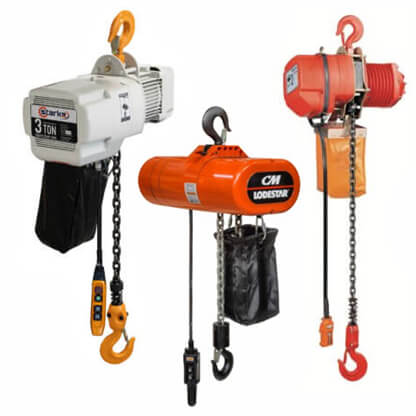
Electric Hoists
Electric hoists are powered by you guessed it, Frank Stallone… er, I mean electricity!
Electric hoists use powerful motors to lift whatever you hook them up to.
These hoists are used in a variety of industries from construction to manufacturing plants.
Some things to consider with electric hoists is the number of lifts you’ll need to make per hour.
Because these hoists are powered by electricity, they are prone to heating up more than some of the manual or pneumatic hoists.
You really don’t want your motor to get too hot as that can cause severe damage to the motor and could cause a catastrophic failure.
So, knowing how many times you’ll need to lift material, start and stop the crane, and how long your lifts will take are all important factors in finding the right electric hoist.
Here is a guide on hoist duty classifications.
The grade of electric hoist will determine how frequently you can use it and may also correlate with the amount you can lift.
All these factors come into play when you consider the longevity of your hoist.
If you overwork a hoist, don’t be surprised when you have to replace it sooner rather than later.
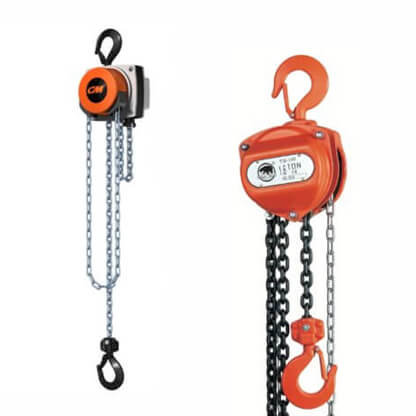
Manual Hoists
Manual hoists are powered by a gear system like the other hoists, but what turns those gears is actually the hoist operator.
Because of the differing gear ratios, the operator can expend just a little bit of work to spin a small gear, which moves a series of larger gears.
The end result is that the hoist operator is able to power this whole lift by themselves.
Manual hoists are very simple hoists, with a wide range of lift capacity from a few thousand pounds to 50 tons.
Because they operate via a simple gear system which is manually operated, you don’t need to worry about things like start/stop times, overheating a motor, or even being near a power source.
This makes manual hoists the perfect option for a lot of farmers or at home mechanics, but also for some small businesses as well.
A woodworking place I worked at some years ago used a manual hoist to lift thousands of pounds of wood.
The only downside in considering a manual hoist is that the more you use it the more tired you’ll get.
So, while the hoist won’t overheat from frequent use, that doesn’t mean you won’t!
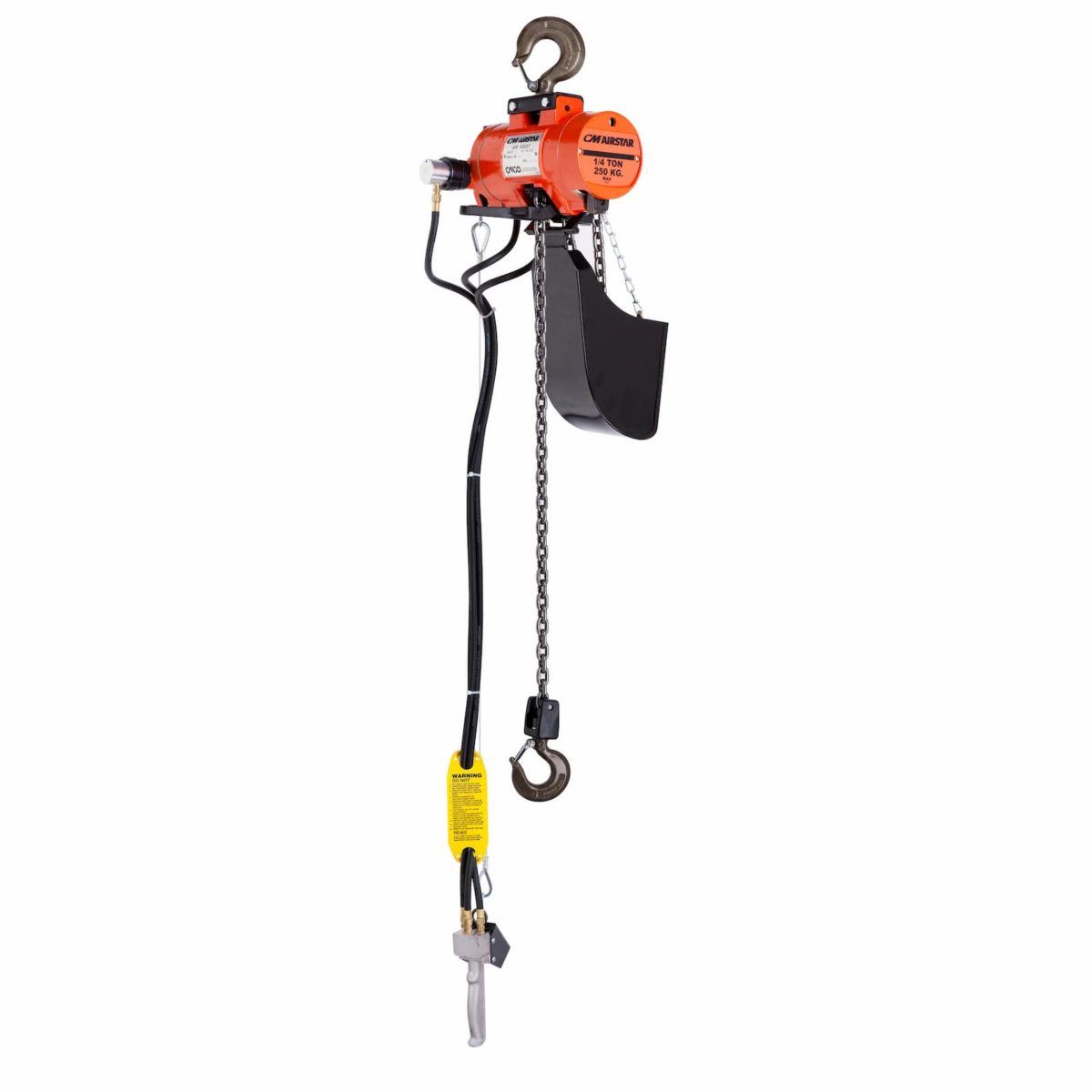
Pneumatic Hoists (Air Hoists)
Sometimes called air hoists, pneumatic hoists use compressed air to power their motor.
Unlike electric hoists which can get very hot, pneumatic hoists are actually cooled through operation due to the air passing through the motor.
This continuous cooling feature means that you can use a pneumatic hoist as much as you need without worrying about the system overheating and becoming damaged or failing.
Pneumatic hoists are also some of the most powerful hoists on the market.
Some of these hoists can lift 100 tons of material!
Because of their huge lifting capacity, they are frequently used in large manufacturing plants and shipyards.
The important thing to remember with pneumatic hoists is to keep their air pressure and air flow at the correct levels.
Maintenance and upkeep are crucial in keeping these hoists running smoothly and ensuring they have a long lifespan.
Load Chain Options
The load chain can change many factors of a hoist.
These factors include lifting capacity, lift height, and cost.
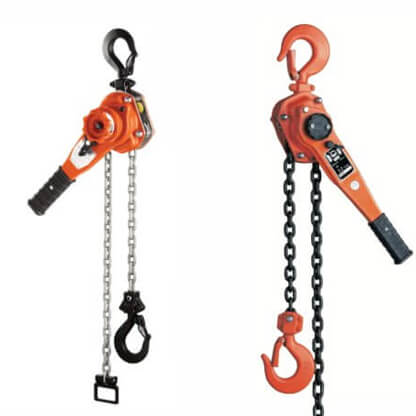
Chain Hoists
Chains are most commonly found on manual hoists.
The chains are easy to grip compared to a wire rope and they are reliable and more cost effective for smaller hoists.
They are a great option for hoists which don’t need to lift more than 25 tons.
Chains can last a very long time as they are extremely durable.
Chain hoists may also be more compact than wire rope hoists, if they don’t have a drum that the chain wraps around.
Some limitations with chains are that they are not usually recommended for lifting objects high in the air.
Usually anything above 20 feet is more suited for a wire rope.
Chains can also limit the lifting speed of a hoist.
While chain hoists can still be powered by electric or pneumatic motors, they are not able to operate as smoothly as a wire rope hoist. This makes them slower and louder to run.
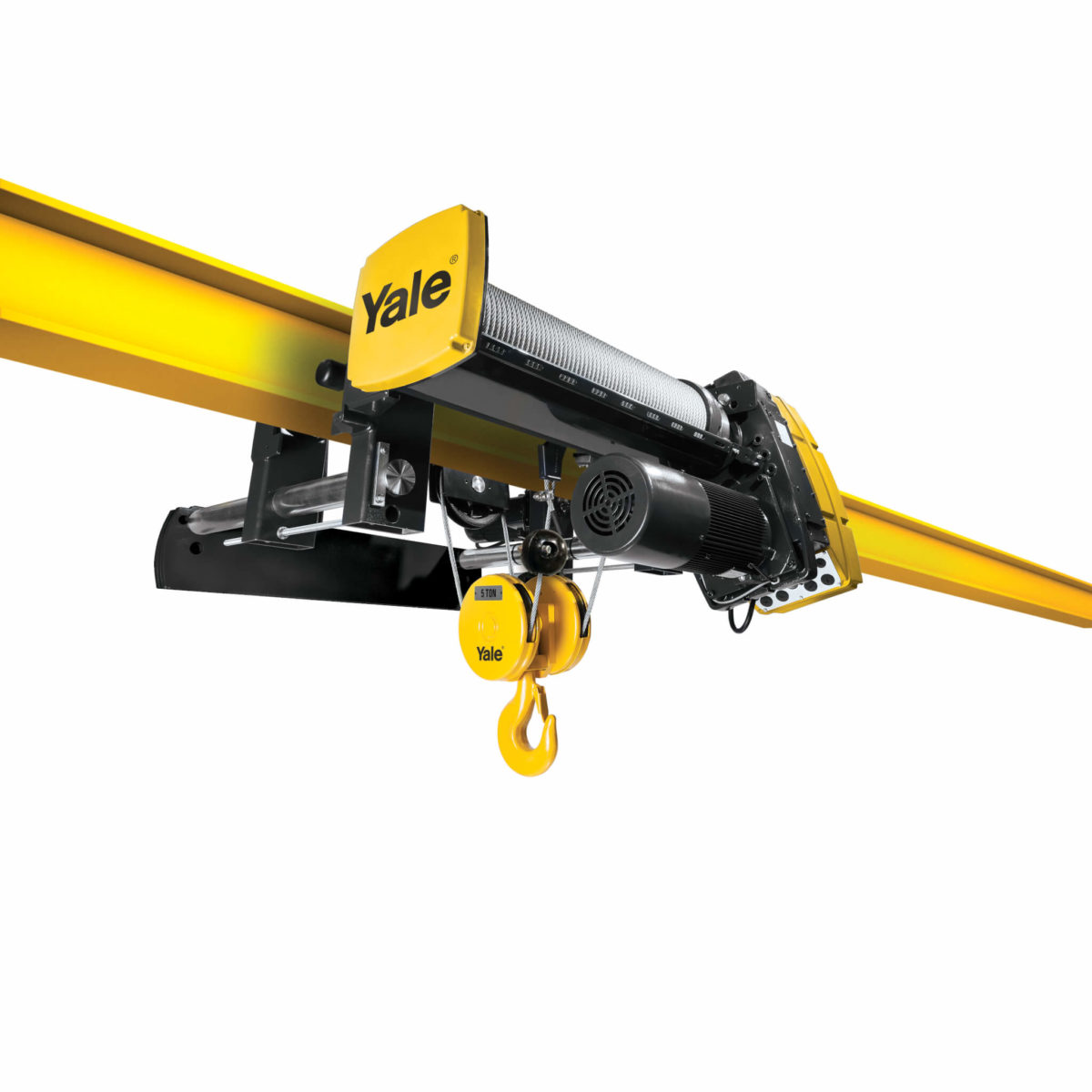
Wire Rope Hoists
Wire ropes are very commonly found on electric and pneumatic hoists.
They offer large lifting capacities due to a wire rope hoist’s tensile strength.
You will find most wire ropes hoists are rated above 10 tons because they are so strong.
They also offer a faster and quieter operation than chain hoists.
Some of the drawbacks with wire rope hoists is that they can be less durable than chains depending on the environment.
They also are typically more expensive than chain hoists and can take up more space due to the drum which the wire rope is wrapped around.
But if you have to lift very heavy loads, and lift material high off the ground, you can’t beat a wire rope hoist.
Mounting Options
The last factor to take into consideration when searching for a hoist, is how that hoist will be mounted.
If you have a bridge crane already set up and just need to replace the hoist, then you’ll already know how your hoist is mounted.
But if you’re looking at installing a crane, then the mounting configuration of the hoist is something to keep in mind before you make your purchase.
Hook-Mounted Crane Hoists
A hook mounted hoist is probably the simplest mounting configuration for a hoist.
A hook on the top of the hoist is used to attach the hoist to either a trolley or fixed position on whatever is supporting the hoist.
Any type of hoist can have a hook mount, but typically these are for chain hoists not wire rope hoists.
The chain is used because it keeps the loading material directly underneath the supporting hook.
Hook mounts are extremely simple and will last as long as the hoist does.
Some challenges with hoists are that you might be limited to a fixed position.
Or if you mount it to a trolley system, you are creating more contact points separating the hoist from its support.
Lug-Mounted Crane Hoists
Lug mounted hoists are attached to a frame via a lug mounting bracket.
The lug mounting bracket is attached to the frame of a hoist. The hoist is then attached to a trolley system or on another support system.
These are very common types of hoist mounts.
They are extremely durable and don’t require much upkeep.
They also offer better lift height than hook mounted hoists.
So if lift height is an important factor you may want to consider going with a lug mounted hoist over a hook mounted hoist.
Trolley-Mounted Crane Hoists
Trolley mounted hoists are more complicated than the previous two types of hoists mentioned.
Some people will call any hoist that is mounted to a trolley, a “trolley-mounted” hoist.
While this is technically correct, what is talked about here will be hoists that have an integrated trolley which is built into the hoist’s frame.
These kinds of crane hoists are convenient in that when you attach your trolley to your support beam, your hoist is ready to go.
But because the trolley is integrated into the hoist frame, if the trolley needs servicing you may end up having to remove the entire hoist.
If there is a failure in trolley mounted hoists, you can expect maintenance to not only cost more than that of the other two kinds of hoists, but also for maintenance to be more complicated and take longer.
That being said, it can be nice to have everything integrated into one device.
This kind of integration can reduce some external or environmental factors which the other kinds of mounts face.
Next Steps
Finding the right kind of hoist for your needs is not a straightforward process.
Hopefully now you’ve got a better understanding of hoists and can move in the right direction, but don’t forget to use other external sources such as contacting PWI.
PWI has met the needs of clients needing hoists and cranes for over 40 years.
Getting your business needs figured out is what we do, so reach out and we’ll be happy to help.
And perhaps you’ve already been thinking about what kind of hoist is best for you.
You know the three key factors of a hoist, so finding the right combination of those factors might have jumped right out to you.
If that is the case and you’re ready to buy, shop for hoists on HoistZone.com.
There are a variety of top brands available like CM, BlackBear, and Starke.
If you want to discuss your needs with a salesman, send a RFQ today.
See Also
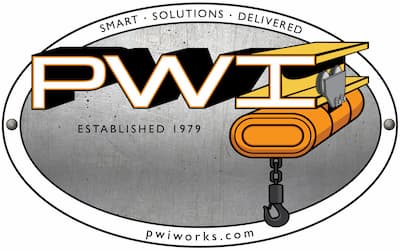

![New Construction vs Mezzanine [PDF]](https://pwiworks.com/wp-content/uploads/new-construction-vs-mezzanine-pdf-464x600.jpg)